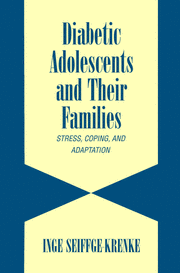Book contents
- Frontmatter
- Contents
- Foreword by Stuart T. Hauser
- Preface
- 1 Epidemiology of Chronic Illnesses in Adolescence
- 2 Coping with Illness in Adolescence: An Overview of Research from the Past 25 Years
- 3 Coping with Diabetes: A Longitudinal Study
- 4 Knowledge of the Illness, Compliance, and Patient–Physician Relationships
- 5 Self-Concept, Body Image, and Perceived Health
- 6 Adolescent, Parental, and Family Coping with Stressors
- 7 Chronic Illness and the Family: The Perspectives of Mothers, Fathers, and Siblings
- 8 Friendships, Romantic Relationships, School, and Career
- 9 Successful Adaptation or the Development of Psychopathology?
- 10 Pathways for Resolving the Dilemma between Developmental Progression and Adaptation to the Illness
- 11 Implications for Prevention and Intervention
- References
- Index
Foreword by Stuart T. Hauser
Published online by Cambridge University Press: 06 August 2009
- Frontmatter
- Contents
- Foreword by Stuart T. Hauser
- Preface
- 1 Epidemiology of Chronic Illnesses in Adolescence
- 2 Coping with Illness in Adolescence: An Overview of Research from the Past 25 Years
- 3 Coping with Diabetes: A Longitudinal Study
- 4 Knowledge of the Illness, Compliance, and Patient–Physician Relationships
- 5 Self-Concept, Body Image, and Perceived Health
- 6 Adolescent, Parental, and Family Coping with Stressors
- 7 Chronic Illness and the Family: The Perspectives of Mothers, Fathers, and Siblings
- 8 Friendships, Romantic Relationships, School, and Career
- 9 Successful Adaptation or the Development of Psychopathology?
- 10 Pathways for Resolving the Dilemma between Developmental Progression and Adaptation to the Illness
- 11 Implications for Prevention and Intervention
- References
- Index
Summary
Several years ago, I was astonished and delighted to discover a European colleague directing a research project which had striking parallels with our longitudinal study of adolescents with a chronic illness. Since the mid-1970s, our research group had been tracking intersections between insulindependent diabetes mellitus and adolescent development (Hauser et al., 1997). Begun within the context of a Diabetes Research and Training Center at the Joslin Diabetes Center, we were examining how adolescents and their families coped with the onset and continued presence of this most common adolescent metabolic illness.
Besides the similar questions being asked by both groups, there were the shared assumptions. We assumed it was improbable that all teenagers with diabetes coped in the same ways. Nor did we expect to find that adolescents with diabetes took the same pathway through the complex teenage years. Dr. Seiffge-Krenke's project and ours also recognized that the lives of these adolescents could not be properly studied unless adolescents' contexts - family, school, medical setting - were also included. When we first started, most studies in this area had been based on special samples, those children and adolescents who were having serious difficulties adjusting to their illness. Consequently, prominent findings in these earlier studies pointed to psychiatric symptoms and disorders. To consider the possibility of multiple developmental pathways, reflecting varied coping processes, we designed our longitudinal studies to include all boys and girls with adolescent-onset diabetes, assessing competence and dysfunction of the adolescents and their families.
- Type
- Chapter
- Information
- Diabetic Adolescents and their FamiliesStress, Coping, and Adaptation, pp. ix - xivPublisher: Cambridge University PressPrint publication year: 2001



